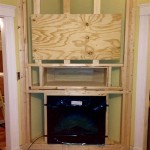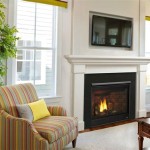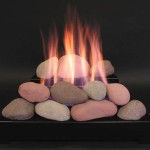How To Clean Sooty Fireplace Bricks
Fireplaces provide warmth and ambiance during colder months, but consistent use inevitably leads to soot buildup on the surrounding brickwork. This soot not only diminishes the aesthetic appeal of the fireplace but, if left unaddressed, can also potentially compromise the brick's integrity over time. Effective cleaning requires understanding the nature of soot, selecting appropriate cleaning materials, and employing safe and methodical cleaning techniques. This article will outline the steps involved in cleaning sooty fireplace bricks, ensuring a restored and visually appealing fireplace.
Before commencing any cleaning process, assessing the type and extent of soot buildup is crucial. Fresh soot, often a light, powdery deposit, is generally easier to remove than older, heavily ingrained soot. The type of brick also influences the cleaning approach. Certain brick types, particularly those with porous surfaces, may require gentler cleaning methods to avoid damage. Observing any existing damage, such as cracks or crumbling mortar, is also critical as forceful cleaning may exacerbate these conditions. Photographing the area before and after cleaning can serve as a useful record of the progress and the effectiveness of the chosen cleaning methods.
Preparation and Safety Precautions
Prior to cleaning, securing the area and implementing necessary safety measures is essential. This involves covering the surrounding floor with drop cloths or plastic sheeting to protect against staining and debris. Gather all necessary cleaning supplies and tools beforehand to avoid interruptions during the cleaning process. Proper ventilation is critical. Open windows and doors to ensure adequate airflow, especially when using chemical cleaning agents. If necessary, use a fan to circulate air. It is imperative to wear appropriate personal protective equipment (PPE). This includes safety glasses to prevent soot or cleaner from entering the eyes, gloves to protect the skin from chemicals and abrasive materials, and a dust mask or respirator to avoid inhaling soot particles. Depending on the severity of the soot and the chosen cleaning method, consider wearing old clothing or a disposable coverall to prevent staining of garments.
The selection of cleaning supplies should be based on the type and severity of soot buildup, as well as the type of brick. A range of cleaning options, from mild to more aggressive, exists. Beginning with the gentlest method and progressing to stronger options as needed is advisable. Household cleaners, such as dish soap mixed with warm water, can be effective for removing light soot deposits. Commercial brick cleaners specifically formulated for soot removal are available at hardware stores. These cleaners often contain stronger detergents and solvents designed to dissolve stubborn soot. A mixture of trisodium phosphate (TSP) and water is a powerful cleaning agent, but it is important to use it with caution and in accordance with the manufacturer's instructions, as it can be harsh on certain surfaces and poses environmental concerns. Baking soda paste, made by mixing baking soda with water to create a thick paste, serves as a mild abrasive cleaner for removing soot and grime. Ensure all cleaning agents are compatible with the brick material to prevent discoloration or damage.
Essential tools for cleaning fireplace bricks include a stiff-bristled brush, such as a scrub brush or masonry brush, for removing loose soot and scrubbing the brick surface. A vacuum cleaner with a brush attachment is useful for removing loose debris and soot particles before and during the cleaning process. Sponges and cloths are necessary for applying cleaning solutions and wiping away residue. A spray bottle is helpful for applying cleaning solutions evenly to the brick surface. A putty knife or scraper can be used to remove stubborn soot deposits, but should be used with caution to avoid scratching the brick. Buckets are needed for holding cleaning solutions and rinsing water. Depending on the height of the fireplace, a stepladder may be required to reach higher areas safely.
Step-by-Step Cleaning Process
Begin by dry cleaning the brick surface. Use the stiff-bristled brush to gently sweep away loose soot and debris. Work from top to bottom to prevent dislodged soot from falling onto already cleaned areas. Use the vacuum cleaner with the brush attachment to remove any remaining loose particles. Pay particular attention to crevices and corners where soot tends to accumulate. This preliminary cleaning step removes the majority of loose soot, making the subsequent cleaning steps more effective.
Next, apply the chosen cleaning solution. Start with the mildest cleaning solution, such as dish soap and water, and test it on a small, inconspicuous area of the brick to ensure it does not cause discoloration or damage. Using a spray bottle or sponge, apply the cleaning solution evenly to the brick surface. Allow the solution to dwell for a few minutes to loosen the soot. Do not allow the cleaning solution to dry on the brick surface, as this can leave a residue. If using a stronger cleaning agent, such as a commercial brick cleaner or TSP solution, follow the manufacturer's instructions carefully and take appropriate safety precautions.
After the cleaning solution has dwelled for the recommended time, scrub the brick surface with the stiff-bristled brush. Use a circular motion to loosen and remove the soot. Apply moderate pressure, but avoid excessive force that could damage the brick or mortar. For stubborn soot deposits, use a putty knife or scraper to gently scrape away the buildup. Take care not to scratch the brick surface. Rinse the brick surface thoroughly with clean water to remove any remaining cleaning solution and loosened soot. Use a sponge or cloth to wipe away the rinse water. Repeat the scrubbing and rinsing process as necessary until the brick is clean and free of soot.
Addressing Stubborn Soot and Final Touches
For stubborn soot that persists after initial cleaning attempts, consider using a baking soda paste. Apply the paste to the affected area and allow it to dry completely. Once dry, scrub the area with a stiff-bristled brush and rinse thoroughly with clean water. Another option is to use a poultice. A poultice is a paste made from absorbent materials, such as diatomaceous earth or bentonite clay, mixed with a cleaning solution. Apply the poultice to the stubborn soot and cover it with plastic wrap. Allow the poultice to dry completely, which may take several hours or overnight. Once dry, remove the plastic wrap and scrape away the dried poultice. Rinse the area thoroughly with clean water. Power washing can be employed in some instances, but should be approached with utmost care. The pressure must be regulated and the appropriate nozzle used to prevent damaging the brick and mortar. It is generally best to consult with a professional for power washing services, especially if the brick is old or delicate.
Once the brick is clean, allow it to dry completely. This may take several hours or overnight, depending on the humidity and temperature. Inspect the brick surface for any remaining soot or stains. Touch up any areas as needed. To protect the clean brick and prevent future soot buildup, consider applying a brick sealant. A brick sealant helps to repel water and prevent soot from penetrating the brick surface. Follow the manufacturer's instructions for application. Clean the surrounding area, including the fireplace hearth and any adjacent surfaces. Remove the drop cloths or plastic sheeting and dispose of them properly. Sweep or vacuum the area to remove any remaining debris. Dispose of used cleaning supplies and cleaning solutions according to local regulations.
Maintaining a clean fireplace is an ongoing process. Regular cleaning helps prevent soot buildup and keeps the fireplace looking its best. Clean the fireplace bricks at least once a year, or more frequently if the fireplace is used heavily. Sweep or vacuum the area around the fireplace regularly to remove loose soot and debris. Have the chimney professionally inspected and cleaned annually to prevent creosote buildup, which is a fire hazard. Burn only seasoned firewood, as it produces less soot than green or damp wood. Consider using a fireplace screen to help contain sparks and soot.

4 Ways To Clean Soot From Brick Wikihow

4 Ways To Clean Soot From Brick Wikihow

How To Clean Soot Off Brick Fireplaces Anew

4 Ways To Clean Soot From Brick Wikihow

How To Clean Fireplace Bricks Simple Practical Beautiful

How To Clean Fireplace Bricks

How To Clean A Brick Fireplace With Scrubbing Bubbles 2024 Today S Homeowner

How To Clean A Brick Fireplace The Family Handyman

How To Clean Fireplace Bricks Cleanup Team

Vane Cottage Chemical Brick Mortar Soot Cleaner 6








